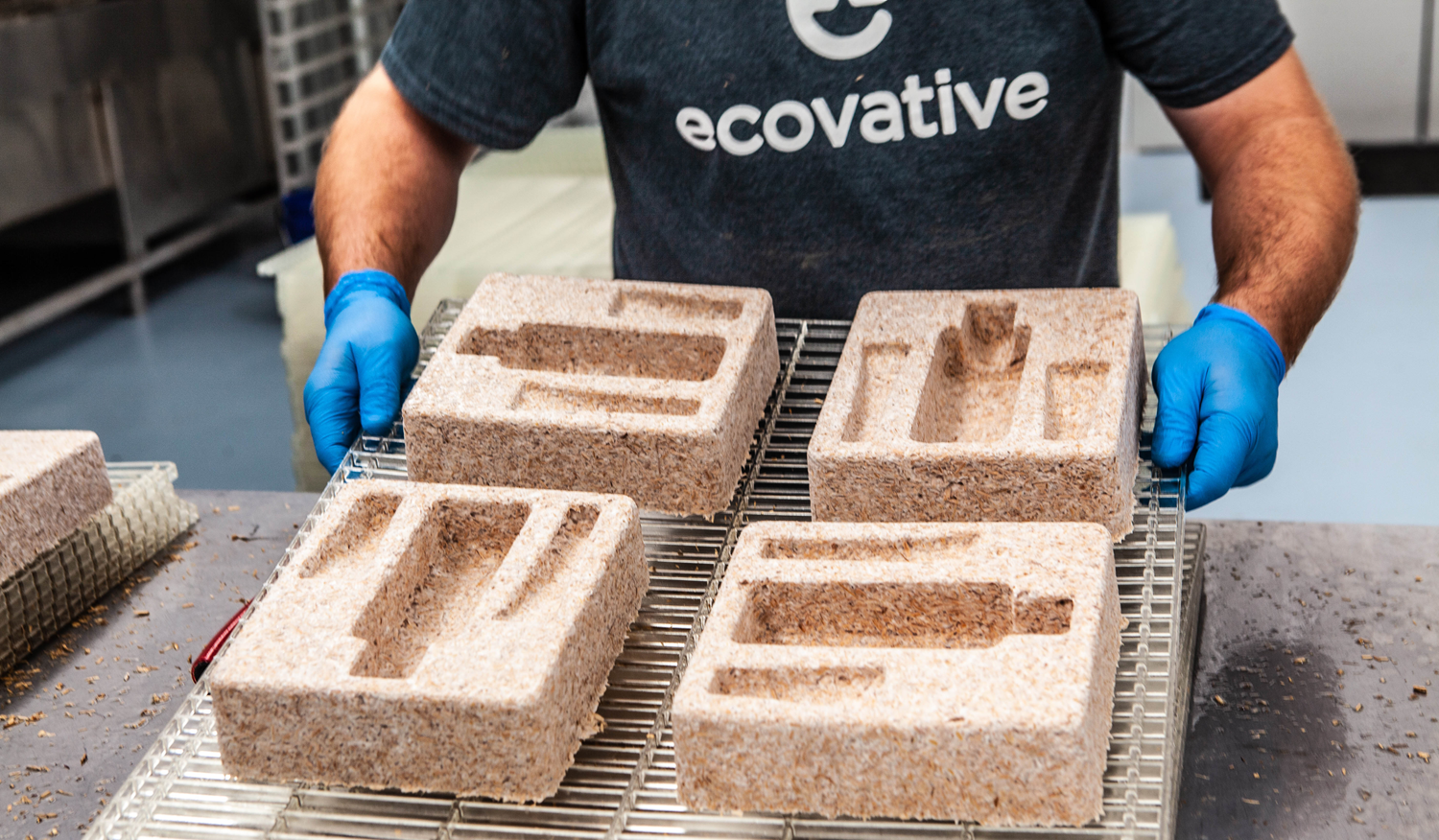Five of the most innovative sustainable packaging solutions

- 12 July 2024
The way we shop has changed considerably. In the UK, over 80% of the population makes e-commerce purchases, and the numbers are still growing. By 2027, the penetration rate among the country's consumers is expected to reach over 86%.
We're becoming more environmentally conscious with our shopping habits, too. According to The Economist Intelligence Unit, there has been a 71% rise in online searches for sustainable goods globally over the past five years.
But if there's plenty of research out there to show businesses that customers value sustainability practices, why is it that, when you order something as small as some dog treats, there's a good chance it'll turn up in a box that's big enough for a vacuum cleaner?
Large packaging makes purchases seem better
We live in a world where many things are determined using software or an algorithm, which is usually pretty reliable. However, humans are often still involved in some part of the process.
In an interview with BBC Worklife, Barry Kronhaus, director of sales and marketing at Sun Packaging Technologies, explained that this is one reason for products ending up in oversized containers: "When you're relying on humans and they've got 100,000 orders to get out, they have to get it done fast." He added that this is even more applicable when customers pay the shipping charges, as it doesn't hurt the company's bottom line to opt for the next size up.
Some companies also recognise the psychological impact packaging can have. Market research company Amsterbrand Marketing claims that large packaging can make a purchase feel like a good deal.
Sustainable practices are not just ethical; they're strategic
There are many contributing factors when it comes to how companies choose their packaging, but excessive and non-recyclable materials are harming the environment. Thankfully, consumers are becoming more aware of these problems, and companies are responding.
Custom Neon, a global manufacturer and retailer of custom-designed LED neon lights and signs, is one example.
CEO and co-founder Jake Munday explains that integrating sustainable practices is not solely a matter of ethics but a strategic business decision.
"Implementing sustainable practices is not just an ethical choice but a strategic one in today's globally conscious market. At Custom Neon, we've witnessed firsthand the impactful journey from conventional practices to more eco-aware operations.
"Our packaging strategy underwent a green overhaul. Adopting recyclable boxes and using soy-based inks was a deliberate move to minimise our environmental footprint. Additionally, we crafted these boxes to custom-fit each sign, which not only reduced packaging material but also safeguarded the product, aligning sustainability with product quality. A challenge we face is eliminating as much waste as possible whilst ensuring that the packaging remains robust enough to protect our LED neon signs," explains Jake.
Of course, there are cost-associated challenges that come with this. According to Raconteur, 43% of brands have cited cost as one of the biggest challenges in switching to sustainable packaging. Munday, however, sees this as an investment in the business: "We realise that today's consumers are looking for this type of commitment to sustainability, so it's an investment in the longevity of our business."
Custom Neon aims to use 70% recyclable/biodegradable internal packaging materials this year. Munday says that clear goals are crucial to achieving these targets: "Setting tangible, measurable goals is vital. It provides a clear direction and a metric for accountability and assessment. Once we hit this target, we'll set ourselves a new goal."
Five of the most innovative sustainable packaging examples
Research indicates that organisations integrating sustainability into their business models are 75% more likely to report substantial revenue growth from these efforts and 52% more likely to outperform their peers in profitability. While there are still many challenges ahead, it's reassuring to see businesses getting innovative with their packaging in a bid to save the planet. Here are some examples.
Lush
If you're familiar with the British cosmetics company Lush, you'll probably be aware of its employees' "aggressively friendly" reputation.
me: h-
— christofer drew funko pop (@ChrisMustard) December 4, 2017
Lush employee: Hey how’s it going welcome into the shop what’s bringing you in today have you ever eaten a bath bomb before do you ever get nervous let me try this gluten free soap out on you i like your docs are you high right now?
There is, however, a reason why you find yourself face to face with a shop assistant before you can even say "Hi". To cut down on packaging and unwanted products, Lush views personal service as "the best environmental practice". It believes that by connecting the consumer with the appropriate product, they get good value for money, Lush gets a regular customer, the consumption of unneeded products falls, and money isn't wasted. 66% of Lush's products sold each year are 'naked' (no packaging). It also operates a "Bring It Back" scheme, meaning customers can bring back qualifying packaging in return for money off or a free face mask after five items.
But it doesn't stop in-store. Solid products are shipped naked, while squidgy ones use biodegradable, compostable cellulose wrap. It also uses sheet board in manufacture, which means that the boxes use less cardboard and generate less waste whilst still being made from 100% recycled material. You may remember that it used to use popcorn to protect its products, but it's now switched to Eco Pops (made from potato starch). These are made in-house and have cut out 24,000kms of lorry miles per year.
Ecovative
Biomaterials company Ecovative is redefining sustainable packaging by harnessing the power of mycelium, the root structure of mushrooms. Its packaging solutions are fully compostable and have already been adopted by industry leaders like IKEA and Dell for shipping products.


But it's not stopping at packaging. The company is expanding into other markets, such as food and textiles, providing innovative and eco-friendly alternatives that could revolutionise these industries.
Notpla
Notpla creates innovative plastic alternatives using seaweed and plant-based materials. From food containers to laundry sachets, the company works with brands to develop new packaging solutions and grow them into products ready for manufacturing.
One example is its partnership with luxury watchmaker ID Genève, a brand that prioritises sustainability. Together, they created the first home-compostable packaging for the luxury watchmaking industry. The box itself is made entirely from seaweed, and once it's submerged in water for a few hours, it dissolves into a liquid that can be used to fertilise plants.
Capréa
While plantable packaging isn't entirely new, it represents a significant leap forward for the beauty industry, which produces at least 120 billion units of packaging each year. But it's not all doom and gloom, as many cosmetic brands are waking up to the problem.
Capréa, an environmentally conscious beauty brand, utilises 100% plantable sleeves for its products. Customers can easily discard the packaging at home by planting it, where it grows into flowers.
Gousto
Sales of meal kits and recipe boxes soared during lockdown. Unfortunately, they brought an unfortunate downside - excessive plastic waste. In 2019, a tweet went viral that showed 32 pieces of plastic from a single HelloFresh recipe box, highlighting a big issue for waste-conscious consumers.
Erm, @HelloFreshUK, this is all the plastic from one delivery box. Tiny sachets of vinegar, pots of dried herbs etc. There are 32 pieces of plastic here. One a week for a year would generate 1,600+ pieces. Your 850k customers worldwide are throwing away BILLIONS. What’s the plan? pic.twitter.com/znx3twBooF
— Everyday Plastic (@PlasticEveryday) September 18, 2019
The industry has been actively working to solve this problem. In 2019, Gousto, another recipe box brand, pledged to reduce its consumption of single-use plastics by 50%, which it achieved in January 2020. That same year, it introduced an innovative solution: the Eco Chill Box, insulated packaging made entirely from recycled cardboard that keeps fresh food chilled during delivery. Previously, Gousto used wool liners that required plastic wrapping, but the Eco Chill Box has enabled it to eliminate 74.5 tonnes of plastic from its packaging annually.
Final thoughts
While things are definitely moving in the right direction, there's still plenty more work to be done. Addressing the issue of unsustainable packaging requires a comprehensive approach that tackles the entire supply chain, while a tough economy presents another challenge altogether for organisations.
The good news is that evidence shows that sustainable businesses are not only attractive to consumers but also resilient and profitable. Companies have an opportunity to lead this transformation, shaping how products are provided and enriching the consumer experience along the way.
Want to brush up on your sustainability skills? Our new online training course, ‘Effective Sustainable Communications, focuses on rethinking marketing through a responsible lens. You’ll look at the words and language you use to connect with your audience and create engaging narratives that inspire action beyond sales.

- 0 views

 FAQs
FAQs
 Log in
Log in
 MyCIM
MyCIM






